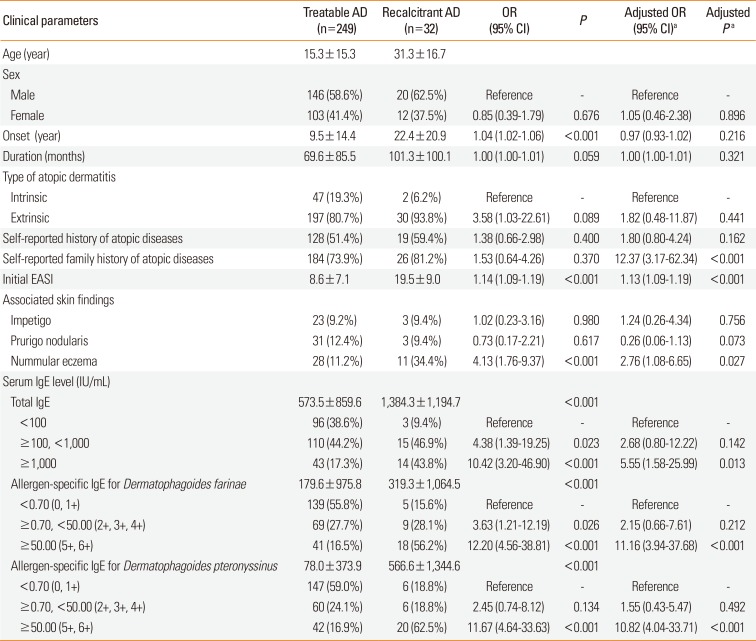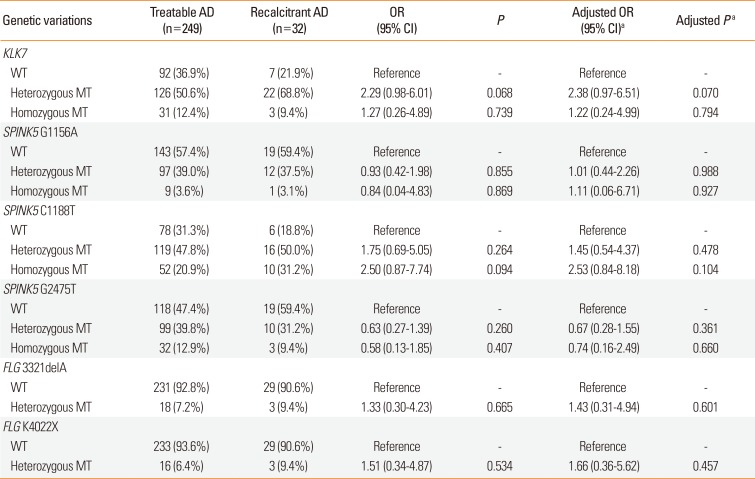1. Patrizi A, Pileri A, Bellini F, Raone B, Neri I, Ricci G. Atopic dermatitis and the atopic march: what is new? J Allergy (Cairo). 2011; 2011:279425. PMID:
21941575.

2. Scharschmidt TC, Segre JA. Modeling atopic dermatitis with increasingly complex mouse models. J Invest Dermatol. 2008; 128:1061–1064. PMID:
18408744.

3. Bieber T, Novak N. Pathogenesis of atopic dermatitis: new developments. Curr Allergy Asthma Rep. 2009; 9:291–294. PMID:
19656476.

4. Barker JN, Palmer CN, Zhao Y, Liao H, Hull PR, Lee SP, et al. Null mutations in the filaggrin gene (FLG) determine major susceptibility to early-onset atopic dermatitis that persists into adulthood. J Invest Dermatol. 2007; 127:564–567. PMID:
16990802.

5. Hubiche T, Ged C, Benard A, Leaute-Labreze C, McElreavey K, de Verneuil H, et al. Analysis of SPINK 5, KLK 7 and FLG genotypes in a French atopic dermatitis cohort. Acta Derm Venereol. 2007; 87:499–505. PMID:
17989887.

6. Vasilopoulos Y, Cork MJ, Murphy R, Williams HC, Robinson DA, Duff GW, et al. Genetic association between an AACC insertion in the 3'UTR of the stratum corneum chymotryptic enzyme gene and atopic dermatitis. J Invest Dermatol. 2004; 123:62–66. PMID:
15191543.

7. Chen H, Common JE, Haines RL, Balakrishnan A, Brown SJ, Goh CS, et al. Wide spectrum of filaggrin-null mutations in atopic dermatitis highlights differences between Singaporean Chinese and European populations. Br J Dermatol. 2011; 165:106–114. PMID:
21428977.

8. O'Regan GM, Irvine AD. The role of filaggrin loss-of-function mutations in atopic dermatitis. Curr Opin Allergy Clin Immunol. 2008; 8:406–410. PMID:
18769192.
9. Enomoto H, Hirata K, Otsuka K, Kawai T, Takahashi T, Hirota T, et al. Filaggrin null mutations are associated with atopic dermatitis and elevated levels of IgE in the Japanese population: a family and case-control study. J Hum Genet. 2008; 53:615–621. PMID:
18521703.

10. Briot A, Deraison C, Lacroix M, Bonnart C, Robin A, Besson C, et al. Kallikrein 5 induces atopic dermatitis-like lesions through PAR2-mediated thymic stromal lymphopoietin expression in Netherton syndrome. J Exp Med. 2009; 206:1135–1147. PMID:
19414552.

11. Fortugno P, Bresciani A, Paolini C, Pazzagli C, El Hachem M, D'Alessio M, et al. Proteolytic activation cascade of the Netherton syndrome-defective protein, LEKTI, in the epidermis: implications for skin homeostasis. J Invest Dermatol. 2011; 131:2223–2232. PMID:
21697885.

12. Namkung JH, Lee JE, Kim E, Byun JY, Kim S, Shin ES, et al. Hint for association of single nucleotide polymorphisms and haplotype in SPINK5 gene with atopic dermatitis in Koreans. Exp Dermatol. 2010; 19:1048–1053. PMID:
21087323.

13. Yoon NY, Wang HY, Jun M, Jung M, Kim DH, Lee NR, et al. Simultaneous detection of barrier- and immune-related gene variations in patients with atopic dermatitis by reverse blot hybridization assay. Clin Exp Dermatol. Forthcoming 2018.

14. Park HW, Shin ES, Lee JE, Kwon HS, Chun E, Kim SS, et al. Multilocus analysis of atopy in Korean children using multifactor-dimensionality reduction. Thorax. 2007; 62:265–269. PMID:
17121871.

15. Kim E, Lee JE, Namkung JH, Kim PS, Kim S, Shin ES, et al. Single nucleotide polymorphisms and the haplotype in the DEFB1 gene are associated with atopic dermatitis in a Korean population. J Dermatol Sci. 2009; 54:25–30. PMID:
19135873.

16. Jurevic RJ, Bai M, Chadwick RB, White TC, Dale BA. Single-nucleotide polymorphisms (SNPs) in human beta-defensin 1: high-throughput SNP assays and association with Candida carriage in type I diabetics and nondiabetic controls. J Clin Microbiol. 2003; 41:90–96. PMID:
12517831.
17. Wright RJ, Finn P, Contreras JP, Cohen S, Wright RO, Staudenmayer J, et al. Chronic caregiver stress and IgE expression, allergen-induced proliferation, and cytokine profiles in a birth cohort predisposed to atopy. J Allergy Clin Immunol. 2004; 113:1051–1057. PMID:
15208584.

18. Namkung JH, Lee JE, Kim E, Cho HJ, Kim S, Shin ES, et al. IL-5 and IL-5 receptor alpha polymorphisms are associated with atopic dermatitis in Koreans. Allergy. 2007; 62:934–942. PMID:
17620072.

19. Namkung JH, Lee JE, Kim E, Park GT, Yang HS, Jang HY, et al. An association between IL-9 and IL-9 receptor gene polymorphisms and atopic dermatitis in a Korean population. J Dermatol Sci. 2011; 62:16–21. PMID:
21371865.

20. Lee SY, Yu J, Ahn KM, Kim KW, Shin YH, Lee KS, et al. Additive effect between IL-13 polymorphism and cesarean section delivery/ prenatal antibiotics use on atopic dermatitis: a birth cohort study (COCOA). PLoS One. 2014; 9:e96603. PMID:
24848505.
21. Park BL, Kim LH, Choi YH, Lee JH, Rhim T, Lee YM, et al. Interleukin 3 (IL3) polymorphisms associated with decreased risk of asthma and atopy. J Hum Genet. 2004; 49:517–527. PMID:
15372320.

22. Namkung JH, Lee JE, Kim E, Kim HJ, Seo EY, Jang HY, et al. Association of polymorphisms in genes encoding IL-4, IL-13 and their receptors with atopic dermatitis in a Korean population. Exp Dermatol. 2011; 20:915–919. PMID:
21913997.

23. Kim E, Lee JE, Namkung JH, Park JH, Kim S, Shin ES, et al. Association of the single-nucleotide polymorphism and haplotype of the interleukin 18 gene with atopic dermatitis in Koreans. Clin Exp Allergy. 2007; 37:865–871. PMID:
17517100.

24. Park KY, Park MK, Kim EJ, Lee MK, Seo SJ. FCepsilonRI gene promoter polymorphisms and total IgE levels in susceptibility to atopic dermatitis in Korea. J Korean Med Sci. 2011; 26:870–874. PMID:
21738338.
25. Manzouri B, Ohbayashi M, Leonardi A, Larkin DF, Ono SJ. Characterization of dendritic cell phenotype in allergic conjunctiva: increased expression of FcεRI,, the high-affinity receptor for immunoglobulin E. . Eye (Lond). 2009; 23:2099–2104. PMID:
19098700.

26. Zedan K, Rasheed Z, Farouk Y, Alzolibani AA, Bin Saif G, Ismail HA, et al. Immunoglobulin e, interleukin-18 and interleukin-12 in patients with atopic dermatitis: correlation with disease activity. J Clin Diagn Res. 2015; 9:WC01–WC05.

27. Kim JE, Kim HJ, Lew BL, Lee KH, Hong SP, Jang YH, et al. Consensus guidelines for the treatment of atopic dermatitis in Korea (part II): systemic treatment. Ann Dermatol. 2015; 27:578–592. PMID:
26512172.

28. Ching GK, Hon KL, Ng PC, Leung TF. Filaggrin null mutations in childhood atopic dermatitis among the Chinese. Int J Immunogenet. 2009; 36:251–254. PMID:
19602001.

29. Fölster-Holst R, Stoll M, Koch WA, Hampe J, Christophers E, Schreiber S. Lack of association of SPINK5 polymorphisms with nonsyndromic atopic dermatitis in the population of Northern Germany. Br J Dermatol. 2005; 152:1365–1367. PMID:
15949016.

30. Ovaere P, Lippens S, Vandenabeele P, Declercq W. The emerging roles of serine protease cascades in the epidermis. Trends Biochem Sci. 2009; 34:453–463. PMID:
19726197.

31. Palmer CN, Irvine AD, Terron-Kwiatkowski A, Zhao Y, Liao H, Lee SP, et al. Common loss-of-function variants of the epidermal barrier protein filaggrin are a major predisposing factor for atopic dermatitis. Nat Genet. 2006; 38:441–446. PMID:
16550169.
32. Park KY, Li K, Seok J, Seo SJ. An analysis of the filaggrin gene polymorphism in Korean atopic dermatitis patients. J Korean Med Sci. 2016; 31:1136–1142. PMID:
27366014.

33. Morizane S, Yamasaki K, Kajita A, Ikeda K, Zhan M, Aoyama Y, et al. TH2 cytokines increase kallikrein 7 expression and function in patients with atopic dermatitis. J Allergy Clin Immunol. 2012; 130:259–261.e1. PMID:
22521249.

34. Vasilopoulos Y, Sharaf N, di Giovine F, Simon M, Cork MJ, Duff GW, et al. The 3′-UTR AACCins5874 in the stratum corneum chymotryptic enzyme gene (SCCE/KLK7), associated with atopic dermatitis; causes an increased mRNA expression without altering its stability. J Dermatol Sci. 2011; 61:131–133. PMID:
21168996.

35. Chavanas S, Bodemer C, Rochat A, Hamel-Teillac D, Ali M, Irvine AD, et al. Mutations in SPINK5, encoding a serine protease inhibitor, cause Netherton syndrome. Nat Genet. 2000; 25:141–142. PMID:
10835624.

36. Park HW, Lee JE, Shin ES, Lee JY, Bahn JW, Oh HB, et al. Association between genetic variations of vascular endothelial growth factor receptor 2 and atopy in the Korean population. J Allergy Clin Immunol. 2006; 117:774–779. PMID:
16630933.

37. Segat L, Guimaraes RL, Brandao LA, Rocha CR, Zanin V, Trevisiol C, et al. Beta defensin-1 gene (DEFB1) polymorphisms are not associated with atopic dermatitis in children and adolescents from northeast Brazil (Recife, Pernambuco). Int J Dermatol. 2010; 49:653–657. PMID:
20618470.

38. Prado Montes de Oca E, Li W. Human beta-defensin 1 (DEFB1) allele and genotype frequencies probably impact on ethnic susceptibility to atopic dermatitis. Int J Dermatol. 2013; 52:115–117. PMID:
23278620.







 PDF
PDF ePub
ePub Citation
Citation Print
Print



 XML Download
XML Download